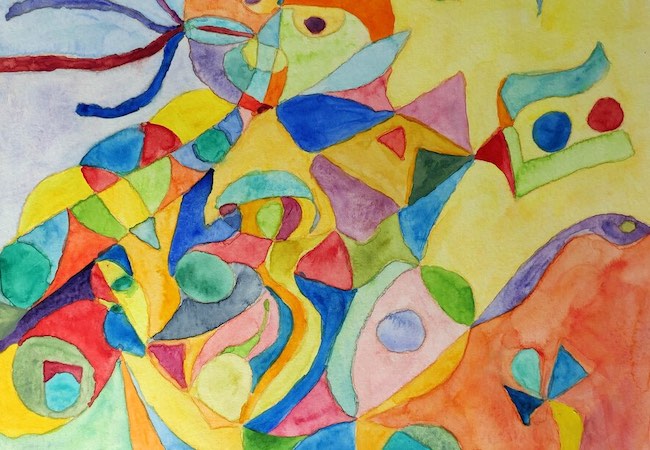Alcuni artisti hanno bisogno di sintonizzarsi sulle frequenze delle tonalità più vivaci, perché si accordano in maniera migliore e più profonda alla propria indole espressiva oltre che alla personalità in virtù della quale essi si approcciano al mondo, osservandone il lato più giocoso, più divertente e ironico; spesso proprio a causa di questo punto di vista solare e sorridente, lo stile pittorico che meglio si adatta a un tale sguardo fanciullesco è quello meno reale, più indefinito perché è anche attraverso di esso che è possibile per questa categoria di creativi, riuscire a innalzarsi dalla contingenza e guardare con aperta curiosità tutte le forme che la realtà immaginata può assumere. La protagonista di oggi appartiene a questo gruppo di artisti e riesce con la gamma cromatica che la contraddistingue a infondere nell’osservatore quel senso di ironia e di divertimento di cui dovrebbe essere piena la vita di ciascuno.
I primi decenni del Novecento furono forse i più vitali dal punto di vista della ricerca artistica poiché non solo decretarono la fine dell’arte accademica con le sue rigide regole espressive e cromatiche, ma introdusse anche il concetto, fino a poco prima tralasciato, di libertà degli artisti di declinare le linee guida dei movimenti secondo la propria più intrinseca attitudine; non solo, il concetto di personalizzazione introdusse di conseguenza anche quella soggettività dell’esecutore dell’opera che fino a qualche decennio prima era completamente esclusa dall’arte. L’affermarsi di alcuni movimenti che rinnegarono la realtà oggettiva per tendere verso nuove forme espressive, diede l’opportunità ai più audaci appartenenti alle varie correnti di mescolare esperienze pittoriche difformi per dare vita a qualcosa di ancor più innovativo. Nel caso dei tre stili che dominarono il primo ventennio del Ventesimo secolo, il Surrealismo, il Cubismo e il Futurismo, si poté assistere in qualche specifico caso a modificazioni e contaminazioni che mostravano la forte influenza di uno stile appena precedente, l’Astrattismo, che ai suoi esordi e nelle intenzioni del suo fondatore Vassily Kandinsky, doveva avere un legame con l’interiorità. Dunque Robert e Sonia Delaunay cambiarono il concetto di Cubismo avvicinandolo in maniera incisiva alla non forma ma effettuando uno studio sul colore che si discostò totalmente dalle tonalità sfumate e terrose di Picasso e di Braque ma soprattutto rinunciando completamente a qualsiasi riferimento figurativo per dare spazio a immagini in cui il rigore geometrico era animato dalla vivacità cromatica; allo stesso modo il Surrealismo, movimento fortemente legato alla resa perfetta del visibile, sebbene le ambientazioni fossero completamente irreali e decontestualizzate per legarsi al mondo dei sogni e degli incubi, trovò il suo ribelle in Joan Mirò che si dissociò completamente dalla rappresentazione di immagini in cui l’occhio potesse trovare riferimenti, per dare spazio a uno stile semplice e immediato che potesse essere compreso in maniera istintiva anche da un bambino, contraddistinto da linee basiche ed essenziali. D’altro canto anche il Futurismo, portato all’eccesso della scomposizione dell’immagine per riprodurre l’idea del movimento, si spinse con Umberto Boccioni quasi a raggiungere la completa astrazione, a dimostrazione di quanto l’indefinitezza avesse la forza di lasciar emergere il sentire e l’intento creativo anche rinunciando alla forma conosciuta.
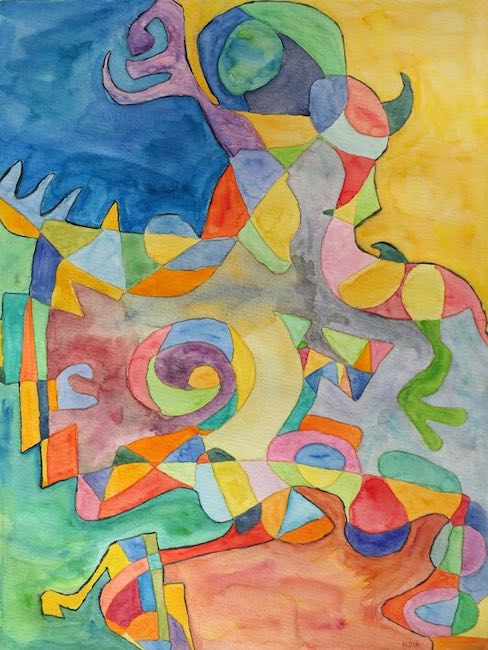
L’artista austriaca Monika Seelig sembra fondere nel suo stile alcuni elementi di tutte e tre le correnti che hanno dominato i primi decenni del Novecento, elaborando un linguaggio al contempo semplice e immediato, pieno di colori luminosi, sfaccettati e tenui, avvalendosi di personaggi immaginari, composti di parti geometriche e sempre curvilinee, grazie ai quali riesce a lasciar emergere il suo approccio positivo e ironico nei confronti della vita; prendersi sul serio è solo un modo per perdere il contatto con il fanciullo interiore che sa invece mantenersi saldo al lato giocoso, alla capacità di non drammatizzare nulla perché in fondo tutto è più semplice e piacevole se lo si guarda con un sorriso.
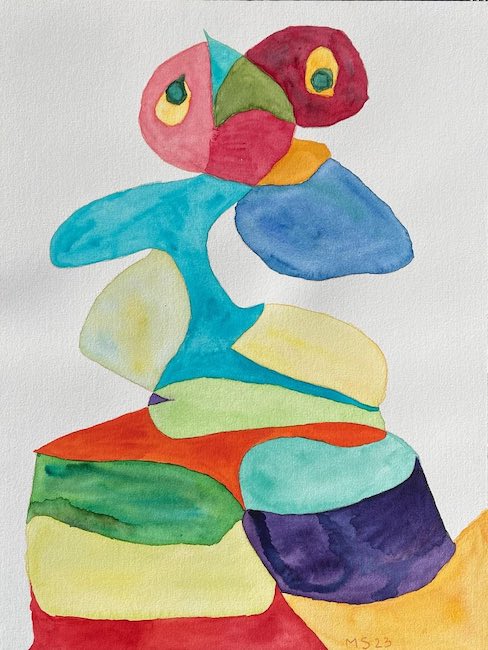
Da un lato non si può non notare la poliedricità coloristica che riconduce alla vivacità del Cubismo Orfico, tanto quanto la geometricità si avvicina a quell’interpretazione dei Delaunay che decretò il distacco dal movimento originario, dall’altro però il mondo di Monika Seelig si avvicina chiaramente a quello di Joan Mirò, alle sue scomposizioni visive, dando vita a personaggi improbabili e divertenti che delinea con tinte luminose, solari, piene di vita esattamente come nel suo mondo ideale dovrebbe essere affrontata l’esistenza.
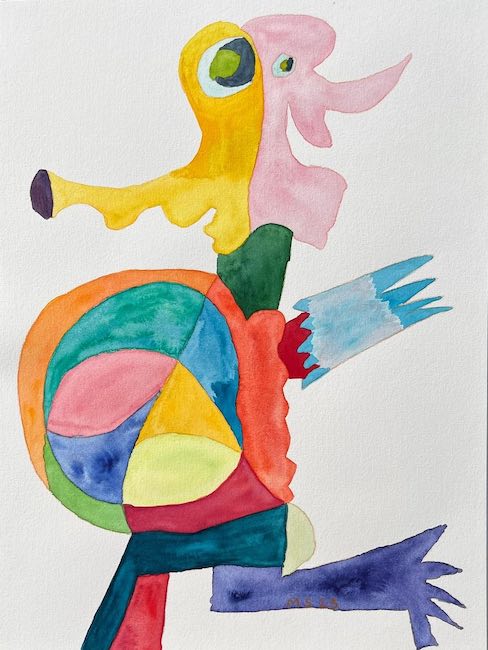
Tuttavia osservando in particolare i suoi acquarelli, non si può non notare il riferimento al movimento, alla velocità che è in fondo metafora dell’esistenza contemporanea, quel dover correre verso qualcosa dimenticandosi di assaporare il bello che ruota intorno; in questo aspetto la sua pittura è riconducibile anche al Futurismo, in particolare a quello più astrattista di Umberto Boccioni, poiché le figure improbabili di cui racconta Monika Seelig sembrano essere ispirate dalla celeberrima scultura Forme uniche della continuità nello spazio.
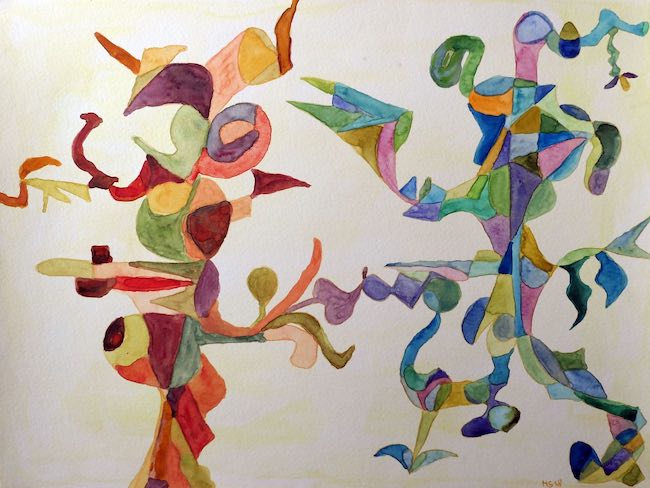
Dunque questa talentuosa artista austriaca riesce a creare un affascinante amalgama tra i tre movimenti del passato che vendono da lei reinterpretati attraverso il filtro della sua positività e della sua leggerezza nell’affrontare tutto ciò che fa parte delle sensazioni e delle emozioni della quotidianità. In LebensLust (Voglia di vivere) i due personaggi sembrano fluttuare, instabili eppure fortemente sorretti da tutte quelle apparenti frammentazioni che costituiscono le ferite, le difficoltà superate, le vittorie quanto le sconfitte, perché in fondo il percorso compiuto non è altro che il bagaglio di esperienze che ciascuno porta con sé, la sua ricchezza, tutto ciò che appartiene alla sua interiorità e dunque, sembra suggerire la Seelig, è molto meglio essere grati e danzare felici per aver oltrepassato tutto essendo ancora in piedi entusiasti di ciò che seguirà dopo, piuttosto che soffermarsi su un’instabilità che diviene ostacolo solo se si decide di considerarla come tale.
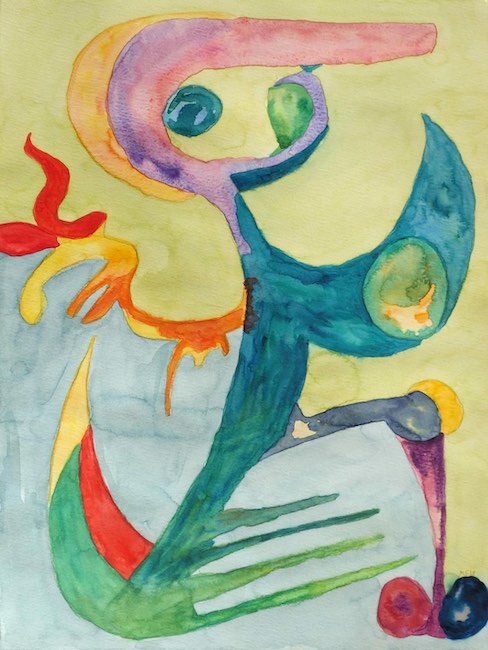
La gamma cromatica dei protagonisti è differente, una sui toni più vivaci e pastello, l’altra in una scala cromatica più scura, autunnale, proprio per sottolineare le differenze caratteriali tra gli individui, i punti di vista e il modo di affrontare le circostanze; eppure entrambi guardano verso la stessa direzione, quella del sorriso, dell’autoironia e della consapevolezza dei propri limiti. In Rapida,
l’opera che più di tutte attinge al movimento futurista, la figura sembra dover correre verso qualcosa, che sia un impegno, una meta o un’illusione non importa perché ciò che desidera mettere in luce l’artista è quella tendenza contemporanea a riempirsi di cose da fare per impedirsi di pensare, di andare a fondo ad analizzare se stessi per paura di scoprire ombre che l’essere umano non vuole vedere. Eppure, suggerisce Monika Seelig, sarebbe sufficiente fermarsi un solo attimo, per comprendere che anche le fragilità contribuiscono a formare tutte le sfaccettature della personalità ed è solo accogliendole e aprendosi a esse che si può trovare la forza di mostrarle pur proteggendole e anche, perché no?, sorriderne esorcizzando così i timori che fino a poco prima inducevano a una costante irrequietezza quasi una fuga perpetua quanto vana da ciò che di fatto era inalienabile perché all’interno di sé.
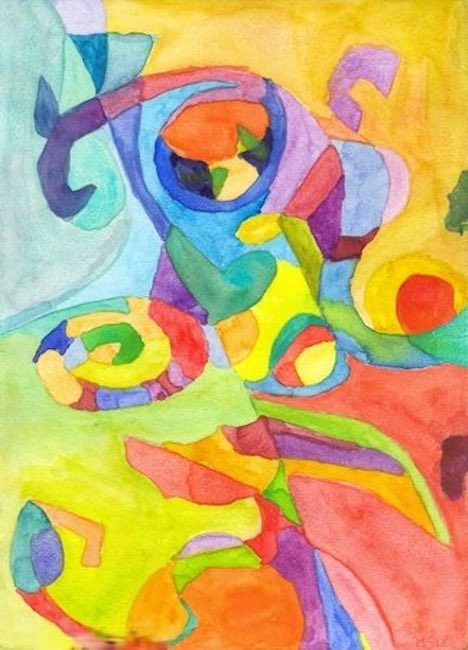
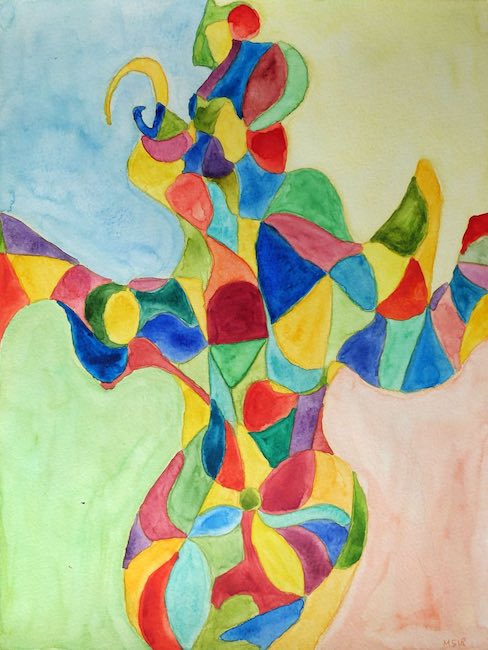
Ma i colori più pieni, più vivaci e vitali, più affini al Cubismo Orfico, sebbene armonizzati alle delicate sfumature interiori di Monika Seelig, sono quelli utilizzati per i lavori dedicati all’estate, Summertime e Summertime II, da cui fuoriesce chiaramente l’amore dell’artista per la stagione più affine alla sua natura, dove tutto è più illuminato dal calore del sole, dove l’essere umano si sente più allegro, più libero di vivere appieno le sue giornate e dove, grazie alle molte ore di luce, è quasi impossibile non trovare il lato positivo dell’esistenza. La spinta ad approfittare di ogni piccolo frammento di vita viene suggerita in modo lieve, immediato poiché è proprio in virtù della semplicità espressiva che è possibile andare a toccare le corde della spontaneità, di quel fanciullo interiore che è all’interno di ciascuno ma che spesso viene lasciato in silenzio, messo in un angolo dall’adulto convinto di non poter far convivere le due parti di sé. Monika Seelig, che utilizza con abilità sia la tecnica dell’acquarello che quella dell’olio e il guazzo, ha alle sue spalle un importante percorso artistico, ha al suo attivo molte esposizioni in Austria e anche in Italia, a Pietrasanta, dove ogni estate soggiorna per far conoscere al pubblico italiano e straniero che affolla le vie della città artistica toscana le sue opere.
MONIKA SEELIG-CONTATTI
Email: moniseelig@hotmail.com
Sito web: www.monikaseelig.com
Facebook: www.facebook.com/monika.seelig.3
Instagram: www.instagram.com/seeligmonika/
All the energy of colour in Monika Seelig’s colourful artworks, between Orphic Cubism and Abstract Surrealism to smile at life
Some artists need to tune in to the frequencies of brighter tones, because they match better and more profoundly to their own expressive nature as well as to the personality by virtue of which they approach the world, observing its more playful, funnier and ironic side; often, precisely because of this sunny and smiling point of view, the painting style that best suits such a childlike gaze is the less real, more undefined one, because it is also through it that it is possible for this category of creative artists to rise above contingency and look with open curiosity at all the forms that imagined reality can take. Today’s protagonist belongs to this group of artists and succeeds, with her distinctive range of colours, in instilling in the observer that sense of irony and fun that everyone’s life should be full of.
The first decades of the twentieth century were perhaps the most vital from the point of view of artistic research since they not only decreed the end of academic art with its rigid expressive and chromatic rules, but also introduced the concept, until recently neglected, of the freedom of artists to decline the guidelines of the movements according to their own most intrinsic aptitude; not only that, the concept of personalisation consequently introduced the subjectivity of the executor of the artwork that until a few decades before was completely excluded from art. The emergence of certain movements that repudiated the objective reality in order to tend towards new forms of expression gave the most daring members of the various currents the opportunity to mix different pictorial experiences in order to create something even more innovative. In the case of the three styles that dominated the first two decades of the 20th century, Surrealism, Cubism and Futurism, is possibile to see in some specific cases modifications and contaminations that showed the strong influence of a style that had just preceded them, Abstractionism, which in its beginnings and in the intentions of its founder Vassily Kandinsky, was supposed to have a connection with interiority. Thus, Robert and Sonia Delaunay changed the concept of Cubism by bringing it incisively closer to non-form, but by carrying out a study on colour that departed totally from the shaded and earthy tones of Picasso and Braque, but above all by completely renouncing any figurative reference to give space to images in which geometric rigour was animated by chromatic vivacity; similarly, Surrealism, a movement strongly tied to the perfect rendering of the visible, although the settings were completely unreal and decontextualised to tie in with the world of dreams and nightmares, found its rebel in Joan Mirò who completely disassociated himself from the representation of images in which the eye could find references, to give space to a simple and immediate style that could be understood instinctively even by a child, marked by basic and essential lines.
On the other hand, Futurism too, taken to the excess of breaking down the image to reproduce the idea of movement, went almost as far as complete abstraction with Umberto Boccioni, demonstrating how indefiniteness had the power to allow the feeling and creative intent to emerge even when renouncing the known form. The Austrian artist Monika Seelig seems to fuse in her style some elements of all three currents that dominated the first decades of the 20th century, elaborating a language that is both simple and immediate, full of bright, faceted and soft colours, making use of imaginary characters, composed of geometric and always curvilinear parts, thanks to which she manages to let her positive and ironic approach to life emerge; taking oneself seriously is just a way of losing touch with the inner child who instead knows how to hold on to the playful side, to the ability not to dramatise anything because, after all, everything is simpler and more pleasant if you look at it with a smile. On the one hand, one cannot fail to notice the colouristic versatility that brings us back to the liveliness of Orphic Cubism, just as much as the geometricity comes close to the Delaunay interpretation that decreed the detachment from the original movement.
On the other hand, however, Monika Seelig‘s world is clearly similar to that of Joan Mirò, to her visual decompositions, giving life to improbable and amusing characters that she delineates with bright, sunny, full of life colours exactly as in her ideal world existence should be approached. However, looking at her watercolours in particular, one cannot fail to notice the reference to movement, to the speed that is basically a metaphor for contemporary existence, that need to run towards something, forgetting to savour the beauty that revolves around it. In this aspect, her painting can also be traced back to Futurism, in particular to the more abstract of Umberto Boccioni, since the improbable figures that Monika Seelig tells us about seem to be inspired by the famous sculpture Unique Forms of Continuity in Space. So this talented Austrian artist manages to create a fascinating amalgam between the three movements of the past that she reinterprets through the filter of her positivity and lightness in dealing with everything that is part of the sensations and emotions of everyday life.
In LebensLust (Lust for Life) the two characters seem to float, unstable and yet strongly supported by all those apparent fragmentations that make up the wounds, the difficulties overcome, the victories as much as the defeats, because in the end the path they have travelled is nothing more than the baggage of experiences that each one carries with them, its richness, everything that belongs to its interiority and therefore, Seelig seems to suggest, it is much better to be thankful and dance happily for having overcome everything while still being enthusiastic about what will follow, rather than dwell on an instability that only becomes an obstacle if one decides to treat it as such. The chromatic range of the protagonists is different, one in brighter, pastel tones, the other in a darker, autumnal colour scale, precisely to emphasise the character differences between the individuals, their points of view and their way of dealing with circumstances; yet they both look in the same direction, that of smiles, self-mockery and awareness of their own limits. In Fast, the work that most of all draws on the Futurist movement, the figure seems to have to run towards something, whether it is a commitment, a goal or an illusion does not matter because what the artist wishes to highlight is that contemporary tendency to fill oneself with things to do in order to prevent from thinking, from going deep into analysing for fear of discovering shadows that the human being does not want to see. And yet, suggests Monika Seelig, it would be enough to stop for just a moment to realise that even frailties contribute to shaping all the facets of the personality, and it is only by welcoming them and opening oneself to them that one can find the strength to show while protecting and even, why not, smile at them, thus exorcising the fears that until recently induced a constant restlessness, almost a perpetual and vain flight from what was in fact inalienable because it was within oneself.
But the fullest, most vivid and vital colours, most akin to Orphic Cubism, albeit harmonised with Monika Seelig‘s delicate inner nuances, are those used for the works dedicated to summer, Summertime and Summertime II, from which clearly emerges the artist’s love for the season most akin to her nature, where everything is more illuminated by the warmth of the sun, where human beings feel more cheerful, more free to live their days to the full and where, thanks to the many hours of light, it is almost impossible not to find the positive side of existence. The urge to take advantage of every little fragment of life is suggested in a light, immediate way, because it is precisely by virtue of expressive simplicity that it is possible to touch the chords of spontaneity, of that inner child that lies within each of us but is often left in silence, put in a corner by the adult convinced that he cannot make the two parts of himself coexist. Monika Seelig, who skilfully uses both the watercolour and oil and gouache techniques, has an important artistic career behind her. she has many exhibitions to her credit in Austria and also in Italy, in Pietrasanta, where she stays every summer to introduce her works to the Italian and foreign public that crowds the streets of this artistic Tuscan city.


